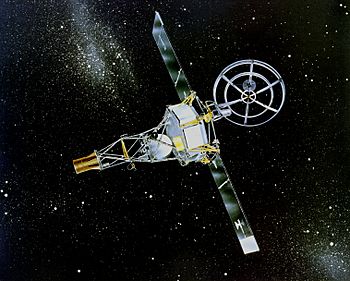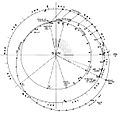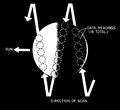Mariner 2 facts for kids

Depiction of Mariner 2 in space
|
|
| Mission type | Planetary flyby |
|---|---|
| Operator | NASA / JPL |
| Harvard designation | 1962 Alpha Rho 1 |
| Mission duration | 4 months, 7 days |
| Spacecraft properties | |
| Spacecraft type | Mariner based on Ranger Block I |
| Manufacturer | Jet Propulsion Laboratory |
| Launch mass | 202.8 kilograms (447 lb) |
| Power | 220 watts (at Venus encounter) |
| Start of mission | |
| Launch date | August 27, 1962, 06:53:14 UTC |
| Rocket | Atlas LV-3 Agena-B |
| Launch site | Cape Canaveral LC-12 |
| End of mission | |
| Last contact | January 3, 1963 7:00 UT |
| Orbital parameters | |
| Reference system | Heliocentric |
| Perihelion | 105,464,560 kilometers (56,946,310 nautical miles) |
| Epoch | December 27, 1962 |
| Flyby of Venus | |
| Closest approach | December 14, 1962 |
| Distance | 34,773 kilometers (18,776 nautical miles) |
|
|
|
Mariner 2 was a NASA spacecraft. It was the second spacecraft in the Mariner program. Mariner 2 was the first successful mission from Earth to another planet.
Contents
Mission
Mariner 2 was launched on August 27, 1962 aboard an Atlas-Agena B rocket at Cape Canaveral Air Force Station. The aim of the Mariner 2 mission was to fly-by the planet Venus and return information on the planet's atmosphere, magnetic field, charged particle environment, and mass. Mariner 2 was at its closest to Venus, at a distance of 34,773 km, on December 14, 1962. Orbital perihelion was on December 27, 105,464,560 km away. The last radio signal from Mariner 2 was received on January 3, 1963. Mariner 2 is still orbiting around the Sun today.
Design
The spacecraft's design was exactly the same as that of Mariner 1. Mariner 1 was the first spacecraft in the Mariner program, but it had to be destroyed shortly after launch because its trajectory was wrong.
Discoveries
The spacecraft found out that the surface temperature on Venus was at least 425 °C (797 °F), on both the day and night sides. It discovered that Venus rotates in the opposite direction from most planets in the Solar System. The spacecraft also found that the atmosphere of Venus is mostly of carbon dioxide and that there is a very high pressure at the planet's surface. Continuous cloud cover was detected but no magnetic field was, however. It also found that solar wind is continuous and that the density of cosmic dust between planets is much lower than it is near Earth.
Images for kids
-
Mariner II trajectory projected on the ecliptic plane.
See also
 In Spanish: Mariner 2 para niños
In Spanish: Mariner 2 para niños











